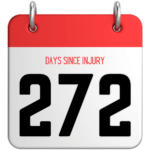Back on the physio table

It has been a week, and today I saw a physio in person.
Jamie Murphy and the team at JAM Physio handled my previous recovery expertly, so I booked back in to see the familiar treatment rooms.
After a few basic questions with Matthew, we went through some posture/walking analysis and then went onto the bed for a physical examination.
This involves pulling and twisting the leg in different ways to test the ligaments and meniscus. These tests include the Lachman Test for the ACL and the McMurray Test for meniscus damage.
Matthew concluded that there is almost certainly meniscus damage, and the ACL feels loose but not ruptured. It could be a partial tear of the ACL, or that could be normal.
I had ACL reconstruction on this knee about 16 years ago, with a hamstring graft harvested from the same leg. Today, I learned that these types of grafts can stretch with age.. which is concerning as it is the preferred method for knee surgeons in the UK.
Over in the USA, it seems that the Patella Tendon graft is preferred. It forms a stronger ligament, although it can cause knee pain issues related to the patella in the long term.

Back on the physio table at JAM Physio with a GameReady ice machine.
The physio appointment was as expected. It’s a formality to be tested physically first before an MRI scan is performed, but the physical tests can only give an idea and can’t be relied upon.
In my previous two ACL ruptures, the physios and doctors all concluded the ACL was intact. The MRI scans showed full and complete ACL tears.
This could be due to my specific physiology (e.g. tight hamstrings or quads), or the injury/swelling causing the knee to tighten.
Anyway, I knew already that this was a formality. I am now referred to see a consultant knee surgeon, Mr. Bilal Barkatali, who will then hopefully send me for an MRI scan.
It will likely be another week until I know exactly what happened to my knee.





